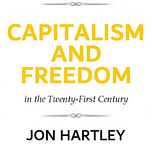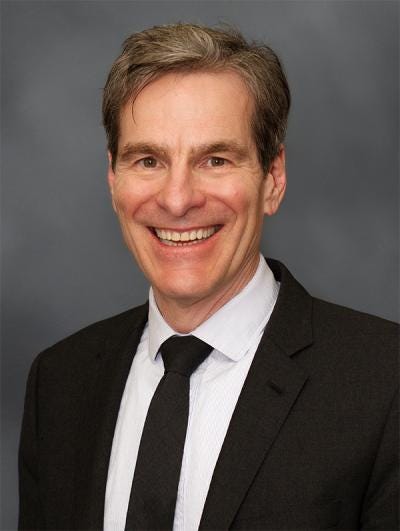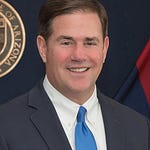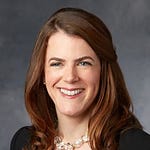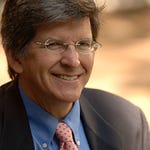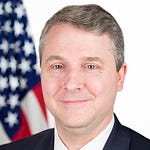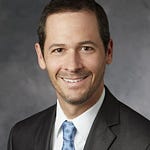John Cochrane, economist and senior fellow at the Hoover Institution at Stanford University, joins the podcast to discuss his career, his new book, The Fiscal Theory of the Price Level, about how inflation can be explained by fiscal and monetary policy, New Keynesian macroeconomic models, consumption-based asset pricing and institutional barriers to economic growth.
Jon: “Welcome to the Capitalism and Freedom in the 21st Century podcast, where we talk about economics, markets, and public policy. I'm Jon Hartley, your host. Today I'm joined by John Cochrane, who is an economist and senior fellow at the Hoover Institution at Stanford University. Previously, he was a professor of finance at the Chicago Booth School of Business. John has just published his new book, The Fiscal Theory of the Price Level, which is a fascinating theory about how the phenomenon of inflation, that is, the rise in nominal prices in the economy, can be explained by fiscal and monetary policy. Welcome, John.”
John: “Thanks, Jon. Pleasure to be here.”
Jon: So, I want to start by getting into how you got into economics. You were a – first, you grew up in Hyde Park. Your father was a history professor, a renaissance history professor at the University of Chicago. You were very interested in science, math, a lot of topics from a very young age. You studied physics as an undergrad at MIT. Then you applied to physics Ph.D. programs and then switched into economics later, partway through your physics Ph.D. program. What got you interested in economics? I'm curious, what was it like being an economics Ph.D. student at Berkeley in the 1980s?”
John: “Yeah. It’s a fun story and I worry that young people today can't do what I do, that that flexibility is hard. I was in the major of the month club for a while. I went to MIT in physics. There were some experiences along there that kind of said where I was headed. I remember one. I was a young kid and I was reading a story while we were in Italy about the Italian government wanted to get rid of – they have poisonous snakes called vipers. They wanted to get rid of the vipers. So, what they did was they offered a bounty of about two bucks a viper. And if you know any economics, you can guess what happened next. The enterprising farmers of Tuscany figured out that they could raise vipers at two bucks a viper and send them truckloads of vipers. So that kind of story stuck with me. Anyway, I was a physics major and I took economics as my humanities distribution requirement and then decided the summer after I graduated that I didn't want to do physics as a profession. I knew I wasn't smart enough to be a theorist and I had no talent at running a lab, so I should find something else to do with my life. I had loved my economics classes. There was a couple of other sorts of conversion moments in there as well, where I understood that economics offered a way of analyzing important problems without the claptrap of politics and values and judgments and morality and so forth. Once one of the things that got me, I saw the budget constraint facing a woman on welfare at the time, where basically you earn $15,001 and they take away your apartment. And I go, well, but, you know, that's me. It's not about values and morals, and it's just, faced with that budget constraint, I'd do the same thing. So that was really an eye-opener, and I decided I liked it, and let's go change majors. So, get this. Imagine you tried this today. I'm into graduate school for physics in a bunch of places, and I wrote them. We used to write letters, you know, on a typewriter. And I wrote them and said, how about I change my major to economics? Now, most of them, you know, MIT, Harvard, Stanford just laughed. But Chicago and Berkeley said, sure, why don't you come join us? This was August. Come join us in September to an economics PhD program. No pre-doc, no letters of recommendation from famous people. You know, here's a guy with a physics degree, pretty good grades. Yeah, why not? And so, I went to Berkeley.”
Jon: “But you turned down Chicago for Berkeley.”
Jhon: “Yeah, I knew it snowed in Chicago, and I knew it didn't snow in Berkeley, and that's about the extent of my graduate school.”
Jon: “And you literally grew up in Hyde Park, too, so maybe a better change of scenery.”
John: “Yes, which might have – it's an interesting question. It turns out Berkeley was right for me. As I look at Chicago's PhD program, I needed, as a physicist, not knowing much economics, I loved my first-year micro and macro because it was supply, demand, equilibrium, optimum, welfare, just boom. This was like a sophomore year physics problem set. I was in California. I had a hang glider. It was a wonderful time. Whereas I know if I'd gone to Chicago, I heard of Gary Becker's class where the class is like instead of, we're going to do, you know, the Slutsky equation today, it was like, okay, why are McDonald's lines longer in the suburbs than the city? And I would have gone, what the hell is this class about? Now, it's been beautiful training for a generation of economists to learn to think like an economist, to create models, and maybe I needed that in my life. But at that point, it was just right for me. It turned out Berkeley was wonderful for general equilibrium. Debrew was still kind of king there. And it mounted a sustained critique on monetarism for reasons I think having to do with sort of their Keynesian proclivities, but a lot of that stuck and became the heart of fiscal theory. I wanted a Chicago theory that survived all the very potent critiques of monetarism that I have learned at Berkeley, so, you know, mixing around is always good.”
Jon: “And so, I mean, there were a lot of others that were there in Berkeley, and they're at Berkeley in the early 1980s. You had, I know, James Stock was a classmate of yours. And I think, to some degree, you credit him in giving some good thinking toward physical theory. And George Akerlof was your advisor. I'm curious, like, you know, it's interesting. It's a very interesting set of people who were there at that time who were guiding your thinking. Then you were hired from there to the University of Chicago. And I'm curious, like, this is at the same time you're on the market the same year that Greg Mankiw was on the market. And it's an interesting year for a macroeconomist on the market, to say the least. When you got to Chicago as an assistant professor, what was it like at that time in the 1980s? Milton Friedman, I'm guessing, had already won his Nobel in the mid-'70s and sort of had left to Hoover, but probably still had some influence. But I'm sure many were still there, like Harry Johnson running his international seminar. I think maybe Art Laffer had left by this point, along with Mundell. But many like Becker, Lucas, and others were there. What was the department culture like when you joined?”
John: “So it was wonderful for me to go to Chicago, and I'm immensely lucky. I've been immensely lucky my whole life, and it was immensely lucky. I think I got my job because Lars Hansen found an interesting mistake in Appendix C of my thesis. Imagine you're a job market candidate. You walk in to Lars Hansen's office, and he kind of looks up, and he says, no, John, there's this interesting question in Appendix C of your thesis. I knew I had fudged Appendix C, but I did it in an interesting way.”
Jon: “Nobody was supposed to read that.”
John: “Exactly. And in many ways, intellectually, as a coming home. I, of course, was already developing as a free marketer from my outside readings. I had discovered real business cycles only by browsing. There was one rainy day when I couldn't go hang gliding, so I went to read articles in the library. And tracing down some unit root stuff, ran across Kivlin and Prescott, Long and Plosser, and I go, oh, my gosh, this is wonderful stuff. And so going to Chicago was home. Now, everybody always thinks the good old days are just over. So, everybody thought, oh, well, you know, you got here too late. You missed the great rational expectation for evolution. But it turned out that it was the dynamic programming revolution. It was real business cycles were in full swing, but the macro workshop run by Bob Lucas development to growth to optimal dynamic public taxation. I'm sorry, I got the optimal public, yeah, optimal dynamic public finance. That's the word I was trying to say.”
Jon: “I think people just call it optimal taxation these days. I don't know.”
John: “Well, it was dynamic and stochastic at the time. Of course, Lars was working out the, not the post GMM stuff, and he had just turned to finance. I turned to finance. So, it was an incredibly exciting time. And now I look back on that. Oh, yeah, that was a good old day. Bob Lucas, by the way, once said, you know, people look back at Chicago and say, it must have been a good old day. He said, no, we always thought that, you know, all the action was happening in Cambridge, and we were just stuck in some cow town, but it turns out that Chicago in the 60s was a good old day too. And I've just learned a tremendous amount. It's wonderful to go to a new place and meet new people and be thrown into the deep end and learn to swim. And what's great about Chicago is partly where I, where again, I worry about our profession these days. I went straight there from grad school, no postdoc-y stuff, through me in the deep end. I taught three different PhD classes every year, where, you know, I had just tool up, and then they really cared that those were taught right.”
Jon: “And you would teach, like, you've taught like micro, macro and metrics.”
John: “Yep.”
Jon: “Like you've done, I can't say that I've met anyone else that can claim that [Inaudible 10:25].”
John: “Well, that's where you, you know, you only learn things by having to teach them. And I learned, I learned a lot by being there. It was a very, now I'm told that I was, I was different by being so brash, but I experienced that as a very, as a place that wasn't very rank conscious. People were in their offices. So, I just walked into Lars Hansen's office or Bob Lucas's office or Jean Fama's office and talk to them like colleagues. And they talked to me like colleagues. And I would, you know, I gave them comments on their papers and they gave me comments on mine. And then nobody told me you weren't supposed to do that. But, you know, it's just a tremendous learning experience. We need to flatten our institutional cultures. I don't, I don't see that now people, you know, at Booth, young people stopped giving me comments on my papers and just said I should give comments on their papers. And I kind of missed that, that, that flat we're all, we're all rowing the boat together ethic that I experienced at the Chicago department.”
Jon: “Well, I think there's also just, you know, fewer comments maybe in seminars in general now, like, you know, there's always these famous Chicago seminar things where, you know, you can't even get three minutes and you can't get to your first slide. I feel like that's a very Chicago kind of thing where now I feel like people want to be nice and understandably, you want to maybe allow somebody to get to the more important parts of their slides. But I don't know what you're going to. People want to be nice, and understandably, you want to maybe allow somebody to get to the more important parts of their slides.”
John: “I don't know what tracks you're going to. I haven't seen anybody.”
Jon: “Or maybe nicer. Some places have the, you know, you can interrupt ten minutes in or something like that. I think Chicago does not have any rules of that nature.”
John: “No. You know, in the 80s, my experience of the culture was that it was productive in the 80s. Well, first of all, people didn't go on for three quarters of an hour on introduction and motivation and literature. They just got to the point. And then there was a, you know, there was, it wasn't the Milton Friedman era where you would do the paper page by page, and everyone had to read it ahead of time. But it was, you know, sharp discussion. Bob Lucas was wonderful. He ran the macro workshop. There was always sort of a king of a workshop. And he wouldn't allow long speeches, the kind of things you see now where, like you said, on the introduction, people are giving long speeches. That didn't happen because Bob wouldn't let it happen. And Gene Fama and Mert Miller ran the finance workshop similarly. And there was incisive discussion, but not the kind of grandstanding that tends to happen.”
Jon: “Very fascinating. And I'm curious, like, you moved over to the Booth School from the Department of Economics at the University of Chicago. How did you get interested in finance in particular? Because, you know, it's interesting how you've come back to sort of macroeconomics with fiscal theory of the price. And all your work sort of is actually both macro and finance. But certainly, the consumption, you know, CKAPM, consumption asset price models are sort of very finance sort of topics. I'm curious, like, what led to your interest in finance in your earlier work? What led you to meeting your co-authors who were, you know, indispensable in that part of your career? And also, you know, not only studying asset pricing, but things like health insurance, where you've had a lot of influence. What got you interested in that sort of finance-y side of your work?”
John: “Well, you know, one of the wonderful things of our profession, if you let it be, is our tools are simple and you can range pretty widely if you want to. You know, I feel sorry for scientists who, at the age of 22, specialize in the 32nd spectral line of chromium, and that's what they're going to do for the rest of their lives. They didn't get that one wrong. And we can range widely. Now, there's some cost in that sort of number of papers goes down. If you're playing a strategic game, a careerist game, there's some cost of not just being the expert on some specific thing. But I've always loved the ability to range widely. And also, life, there's lots of little, life is full of little chances that move you around in unpredictable ways. So, the idea is, I never, when we're interviewing job candidates, I never listen to the what are your research plans. Because I know, just throw that out. You know, your research plan should be, you know, what interesting thing takes you. And I've never known where I was going. So, my story is I started with money and interest rates. My thesis was money and interest rates, heavily colored by time series econometrics. Tom Rothenberg at Berkeley was a god. So, Roger Crane, Tom Rothenberg, and George Akerlof were the holy trinity of where I started from. And I learned a lot of time series by reading Tom Sargent's books. So, I had started on money, interest rates, with spectral analysis. Moved kind of into time series e-macro, hanging out mostly with Lars Hansen at the time he was moving into finance. That really sparked my interest in finance. One big part of my interest in finance was my wife took finance PhD classes at the Booth School and asked me for help on problem sets. So, every Monday night, we were working those problem sets together. And so, I kind of secretly took George Constantinides' PhD class. Also back in Chicago, we used to take each other's classes. So as an assistant professor, I took Lars Hansen's time series finance class. I took other classes in asset pricing. I took Jim Hepburn's econometrics class. I took Rob Townsend's design class.”
Jon: “As a faculty member.”
John: “As a faculty member.”
Jon: “This is something that Sargent talks about a lot, or in his sort of words of wisdom, he suggests even faculty members should at least take one class a year or something like that.”
John: “Yeah, and I keep meaning to do it and haven't gone back to that, but one should. So that was a formative experience. So, I just got interested and started doing finance-y stuff for those reasons. And my interest in finance coincided with not getting tenure at the department and being offered a tenure job at Booth. So, it kind of looked like the fates were aligning that I should go over to Booth, which was a great experience. Booth and the Gene Fama aura is very fact-based. And so, you know, you have to learn the facts of finance, which really helped. And teaching, again, very important for me to teach the Ph.D. classes and MBA classes in finance where I learned what finance was all about. And so, you know, the combination of time series macro real business cycles and then my increasing interest in sort of the beauty of late 80s, early 90s macro finance models produced what I was doing in finance at the time.”
Jon: “So how did you meet John Campbell? And can you explain, like, in simple words, what consumption-based asset pricing is and how that was sort of built on what had come before with sort of basics of CAPM and, you know, Bill Sharpe and Harry Markowitz and sort of that 1960s period.”
John: “Yeah, you know, all economics, like good science, works backwards, and we start with the complicated thing and we end up with the simple thing, and consumption-based asset pricing is asset pricing. It just took us 30 years to figure that out, so if you read my book, Asset Pricing, we do not build up from the older, simpler ones, and consumption-based is the queen of it. That's the history of thought. The fact is, this is the simplest model, and it basically says, how can I say this in one sentence, that people, why are people scared of holding stocks? Why don't they hold more stocks, given the great returns of stocks? And the answer is, because stocks tend to do badly in recessions when you're cutting back on your consumption, so when you're particularly hungry and wish you could look to your stock portfolio and sell some stocks, is exactly when the stocks are doing badly, so the question of all asset pricing is, why do people fear stocks and not hold more of them, and that's the answer of consumption-based asset pricing, and also, technically, it is, if you come from a real business cycle, macro, 1990s macro context, it just, period of asset pricing just falls out of that naturally, so it's an intellectually very clean way of doing things, and it fits in with this huge, empirical base of facts, which is what's wonderful about asset pricing.”
Jon: “Wait, I know you're, you're Campbell Cochran?”
John: “Wait, let me tell you that story, because that's a, again, my theme is, don't try to plan your life, because you never know how it'll work out, just go lots of places, meet lots of people, and little billiard balls will strike, and something interesting will happen. So I got to know, John Campbell was, he, like Greg Mankiw, was the star of our generation, and I met John first at an NBER asset pricing conference, where we had kind of dueling papers on unit routes and random walks, so we got to know each other there, and saw each other at other conferences, and we were at a conference in, an NBER asset pricing conference in Wharton, and I had been working on production-based asset pricing, and I kind of had some ideas of what I wanted to do next, and John thought that was, this was about how to track risk premiums varying over the business cycle, and John had, that was kind of the technology end, and John sort of had the production end, and we said, well, why don't we work together on this? And that's, that's how that started, and that actually was a collaboration entirely by internet, or the nascent internet at the time. I would work on it for a couple months, dump it in his lap, he would work on it for a couple months, dump it in my lap. We actually were together only for a couple of days at a vacation house in Massachusetts that my family used to go to. And I regret not working more with John. We both have kept meaning to go back and finish that project. That project was supposed to end with a theory of business cycles, a theory of general equilibrium, and that was going to... This was just the first of many, but then he got busy in household finance, and I got busy in other things, and it never happened, which is too bad.”
Jon: “Well, an amazing Cambridge-Chicago collaboration, and it's so interesting, too, that it was probably fairly early Internet days. So fast forward here. You're now at the Hoover Institution in a good part of the 2010s, and you spent, on top of starting the Grumpy Economist blog, which is a fantastic blog that I'm sure many of our listeners read, and if they are not reading it, they should. You have spent a good chunk of recent years, of the late 2010s and early 2020s, working on fiscal theory of the present. So going back to your dissertation and getting back to this question of money and prices, not just asset prices, but prices of everyday goods and thinking about inflation. This is a project that you've been working on perhaps longer than anything else, which I think is fascinating. Can you explain just to a layman what the fiscal theory of the price level says?”
John: “Yeah, it says that inflation fundamentally comes from more government debt than people will think the government will repay by the excess of tax overspending. So, it's the same theory as prices present value of dividends applied to government debt. The value of government debt is what people think the government will be able to pay back. And if they don't think there's enough value there, they try to dump the government debt, and the only way to dump the government debt is to buy other stuff, and that drives up the price level. So that's the basic theory. Now, it comes from a 40-year search, as you mentioned. I started really getting interested in money and inflation in graduate school and trying to find a theory that had sort of Chicago analysis but fit the critique of monetarism that I learned in Berkeley. I was looking at it for a long time, wrote my thesis on money and inflation, ran into just a comment on the way to a seminar by Mike Woodford who pointed me to some of the important early work.”
Jon: “This is at Chicago, probably in the 80s.”
John: “Early 90s, actually.”
Jon: “He didn't leave for Princeton until… Yeah, we were at Chicago together, and so he just pointed me to one crucial point that got it going. I actually wrote on it in the 90s. I wrote a paper. I thought I was going to do Friedman and Schwartz fiscal theory in six months. That didn't work out, but the paper taught me lots of other things. I just kept plugging away on it until I knew in the mid-2000s that I needed to write a book to put it all together in one place. I kept trying to do it, and I kept not having the time to do it. Then, Hoover came along and gave me the time to finally finish it, so here we are all these years later.
Jon: “Fantastic. And its so interesting how fiscal theory at the price level has its roots in a lot of research that's been done by macroeconomists like Eric Lieper and Mike Woodford. What I think is so interesting about the fact that a lot of the early fiscal theory papers were in part written by Woodford is that he's since obviously moved on and has been arguably the leading figure in building DSGE models, dynamic stochastic general equilibrium models, which also culminates in his magnum opus, Interest in Prices. I think your book, Fiscal Theory at the Price Level, is very similar in that it's trying to serve a similar function in describing a theory of inflation, but of course one that's very different. I'm curious, you do have some versions of Fiscal Theory at the Price Level in your book that sort of comport with new Keynesian models, and you have a whole chapter, a pretty substantial chapter or set of chapters in your book that talk about integrating Fiscal Theory at the Price Level into the so-called workhorse DSGE models that are used by central banks around the world. I'm curious, why should those central bankers have your book on their shelves right next to Interest in Prices, Woodford's Interest in Prices?”
John: “Because it's right. Now, they're not really that much competitors. Mike's book was sort of the once every 20 years book on monetary policy of that era, and what was so important about Mike's work is he took seriously the fact that central banks set interest rate targets. I love Milton Friedman and MV equals PY, but central banks do not set money supplies.”
Jon: “They tried in the 80s and they failed.”
John: “For a brief period.”
Jon: “And they sort of realized that money demands, they couldn't really control it very well.”
John: “You want to talk about monetary policy, you have to start with I, not M. Central banks set interest rates. And Mike, the whole New Keynesian project, one of the things that I think distinguishes it, it takes that really seriously. And in fact, now, there's some problems with it, which go read the book for some problems with it. But one way to view Fiscal Theory is that it repairs those problems, but then imports 95% of the rest of the structure. One should always build on the good things of what came before. And so, it certainly builds on that. And in particular, explicit economic modeling, dynamic modeling. We think about the economy not as each day in isolation, but when you think about how much you want to spend today, you think about what you've got left for tomorrow. So dynamic optimization is the fancy word for that, and writing down equilibrium models. All that stuff is great of the New Keynesian tradition. And if you want to think about central bank policy mattering and inflation mattering, you have to have some sticky prices or something. So, you can import all of that, but then there's some theoretical problems with it that you fix. When you fix those theoretical problems, you get quite different answers, and you start paying much more attention to the need for monetary and fiscal policy to act, get together. So, fixing that theoretical problem then opens a window to a whole bunch of stuff that they knew about but kind of swept into footnotes and may not have mattered back in an era when debts were small, but actually matters a whole lot more now. So, I view it not so much as a competitor, but I hope a worthy successor. We'll see what Woodford thinks about it. Certainly, or at the very least, bringing public finance back to the fore, because it was so interesting, I think, about the New Keynesian framework and how, in general, we've thought about inflation or approaching inflation over the past few decades is that, really, we should just be focused on interest rates. In fact, it's ISLM in many respects without the M, right?”
John: “Yeah, and let me be specific about that. But what you're saying is sort of a deep contrast with that. Even those that aren't necessarily familiar with the technicalities of the models, the sort of common wisdom of the past 30 years or so, or maybe prior to 2008, was that it was just central banks and interest rates that should be controlling inflation, whereas you're saying public finance, rather than just being something that is just an assumption that we make on the back end that's not very important, has to be brought to the fore.”
John: “So, in standard New Keynesian models, like in monetarist thinking, the central bank is completely in charge of inflation. So, what just happened in 2021 cannot happen, which is something else causes inflation. The Fed does nothing. I mean, 2021, whatever you want to complain about the Fed, is not because they did anything to interest rates, because they just left interest rates absolutely alone for a year. So, this just cannot happen in a view of the world that inflation is always and everywhere just the central bank. The fiscal theory says, hey, a huge deficit like that can cause inflation that the central bank doesn't do anything about. So that's an example of how you just repair a slight little theoretical problem in the New Keynesian-Woodford wave, and all of a sudden you see something that just can't even happen in those models. For concreteness, I'll mention another one. If the Fed raises interest rates today, that's going to raise the interest costs on the debt, and today that's huge. Every 1% that the Fed raises interest rates, the Congress has to come up with $250 billion more interest costs on the debt. Now, that's all sort of in a footnote in Woodford. Oh, yeah, sure, they'll just come up with the money. Wait a minute, maybe they won't come up with the money. So, by thinking more clearly about the fiscal part, you're led to ask, well, what happens if the Fed raises interest rates and Congress does not raise taxes $250 billion each time, they do it?”
Jon: “So, I guess this leads me to another question, and this is something that Eric Leeper's worked a little bit on. What do you think about fiscal policy rules? Like in the sense that when we think about John Taylor's work, and John Taylor was one of these great New Keynesian economists, arguably the Taylor rule is the one part of the whole DSG sort of framework that actually really works well empirically. But I'm curious, like you're sort of taking what you said, that fiscal policy matters in determining inflation. What do you think about fiscal policy rules in the sense that if we really want to keep inflation in a low and stable, doesn't that suggest that there should be some sort of implicit, not necessarily written mechanical rules, but rules in the sense that, for example, the Eurozone, in order to join the Euro, you need to have your debts of GDP under control. I'm curious if that's sort of one maybe corollary of fiscal theory, the price model in terms of managing.”
John: “Yeah, I'm a little frustrated as a child of the 1980s that so much of the 1980s economics is getting forgotten. One thing that seems to be forgotten is the central insight of rational expectations, that we think about policy as a rule, as an institution, not as what are we going to do today. And fiscal theory, like New Keynesian theory, has that feature that you need to think about policy in terms of rules and institutions and expectations for how things are going to happen in the future. So, I'll mention both the Taylor rule and the fiscal rule, which was your question. The Taylor rule, actually being offices next to people is important because I love John Taylor and so I needed to think about what do we do about the Taylor rule in this model, and it wasn't initially obvious. The Taylor rule is a lovely example of something where the answer stays the same and the questions just keep changing. And in this case, that's not a criticism. That's a strong advantage of it. In sort of traditional ISLM models, the Taylor rule, those models are unstable. The economy just blows up if the Fed doesn't do anything, and the Taylor rule stabilizes them. In Woodford's New Keynesian model, it's already stable on its own. The Fed doesn't have to do that, but the Taylor rule removes multiple equilibrium. Totally different thing, but good for totally different reasons. Fiscal theory models, they're already stable and they don't have multiple equilibrium, but it turns out the Taylor rule works really well to stabilize, not to stabilize the economy, but to lower the volatility of inflation. So, if fiscal shocks are coming along, those will cause inflation. If the central bank follows the Taylor rule, it smooths them out almost exactly optimally. That's totally different economics, but again, that particular rule turns out to work really well in lots of different kinds of models. Fiscal rules, now the fiscal part is important. Fiscal rules ought to matter too, and in fact, the key that fiscal theory points to is it is not a theory of debt and deficits cause inflation. It's always a theory of debt and deficits relative to what people think the government can repay over the long run causes inflation. Today's debt can be huge. Today's deficits can be huge if people think it'll get repaid. So, getting people to really trust the government, you're borrowing a lot today, but you'll pay it back tomorrow. That's the key. So, you can have huge deficits and huge debts so long as you persuade people, you're going to pay them back. Well, good rules, traditions, constitutional limits, all that's institutions. Those are the keys to getting people to believe it'll be paid back. So, number one, yes, fiscal rules, traditions, institutions are crucial to price level stability. In fact, the gold standard in fiscal theory of the price level, it's just a fiscal commitment that we're going to come up with the taxes needed to get the gold. Well, that's an example of a fiscal rule that's really good. Not perfect. We don't want to go back to the gold standard. It would be really useful in times of inflation; you want to commit that you're cutting back. And in times of deflation, you want to commit that you're not cutting back. That's just as hard. For whatever reason, our governments wanted more inflation in the 2010s. And even Japan, which did stimulus after stimulus, was never able to convince people that it wasn't going to pay back the debt. So, it's a negative fiscal rule that says as long as there's deflation, we're going to be spending like drunken sailors. That would help stop deflation as much as a positive fiscal rule that says if inflation ever breaks out, trust us, it's austerity and we can't stop it. That's really helpful for limiting inflation.”
Jon: “Absolutely. So, on the topic of John Taylor, you sort of have this prediction now about the Taylor Principle. And the Taylor Principle is sort of part of the Taylor Rule, in a sense, which says that the central bank optimally needs to raise interest rates, nominal interest rates, more than one for one with inflation in order to get real positive interest rates. So positive real interest rates. And you don't think that's necessary, in part because you think really sort of fiscal issues are more dominant. Is that fair to say, what your position is?”
John: “If you work out the standard fiscal theory models, and you know, you have to think through models. The key of economics is don't make it up, have a model. So, we'll just, I'll refer to the simplest possible models in Fiscal Theory of the Price Level, Chapter 5. And one says if there's a fiscal shock and the Fed does nothing, leaves interest rates alone, that inflation will come and then it'll slowly melt away after we've inflated away the debt. So going on that basis, it's okay if the Fed does not move interest rates more than one for one. In Fiscal Theory Experiment 2, however, if the Fed responds by raising interest rates one for one or less, not more than one for one. I was a little bit glib there. If the Fed does raise interest rates in response to inflation, it doesn't have to go all the way up to inflation. In fact, it shouldn't, it shouldn't. It should be less than inflation. That will bring down current inflation at the cost of some future inflation and help stabilize things. So, the Taylor Principle in the Fiscal Theory model, it shouldn't be more than one for one, it should be one for one or less. And unless the inflation will go away, it'll just go away faster if the Fed follows that modified Taylor Principle.”
Jon: “So, one last question here. John, you spent a lot of time talking about also economic growth on top of inflation and I'm curious, over the past few years, since we've seen this big inflationary, and since I think May of 2021, we've seen a lot of very thoughtful people, whether it's the Federal Reserve, other parts of the federal government, within the Biden administration, within the media, within academia, say this is all supply-constrained and supply-driven. And it's, interestingly, been the first time in quite some time where we've heard this. And I remember in my textbook, first economics class in high school, trying to explain the inflations of the 1970s and 1980s as all being supply shocks, and not really talking about the role of the Fed or, say, Arthur Burns, the Arthur Burns Fed. I'm curious, like, do you see a sort of parallel in that debate today, where maybe some people would say, you know, it's this recent inflationary burst, oh, it's all supply shocks, you know, and fiscal policy, all the big recent run-up of debt has nothing to do with this. What do you say to those critics of a sort of fiscal argument of being the cause of the recent early 2020s inflationary spiral?”
John: “Well, to put it here, so a supply shock, like you can't get TVs into the ports, that's going to raise the price of TVs relative to other things. The price of oil has been troubled, and that's the relative price of oil. So don't confuse relative prices and the price level. The price of TVs could go up and wages could go down. Why is it that that makes everything go up? So, inflation always has lots of relative price changes, but the phenomenon is the price of everything going up. So, in one sense, that kind of says it's not, you know, prices wouldn't go up if people didn't have the money to spend on the goods that are in short supply. Then we would just have the wages go down. So, it has to be, to turn into inflation, the supply shock has to be validated by the increase in demand, if you will, by the extra spending. And really, the consensus view of the 70s is that the oil shocks would have been a relative price change, and that it induced the Fed and the government to validate that so that the relative price change meant oil prices went up and nothing else had to go down, and then they overdid it and everything went up. You know, similarly, Europe has an energy, no question, they have an energy supply shock. They don't have as much energy. What are they doing about it? Giving people money in order to buy energy. Well, you can tell what that's going to do. So, a supply shock only turns into general inflation if there's also the increase in demand. But the word supply, you know, the aggregate supply, inflation does tell us we're at the aggregate supply limit. So, in that sense of not enough supply, I wish our friends on the left who are saying supply shock, supply shock would pay more attention because it just means stimulus, secular stagnation, we're done with that. If you want growth now, you got to get more productivity. And so, you know, go back to growth theory. So that sense of supply mattering is important. And the final point, it is kind of distressing for someone, you know, I was a teenager in the 70s and a young economist in the 80s. We're seeing all the same arguments over and over again as if we had not done this just before. I mean, in the early 1970s, inflation came out. What did people say? Oh, it's just a supply shock. Oh, it's greed. Oh, it's profiteering. Oh, it's the great chicken monopoly. Well, not that one, but just about the other ones. Then they said, then, oh, it's a union wage bargaining, different sources of power. We got to 1980 and all the Keynesians saying, oh, we can't, we just need to raise the inflation target because we can't possibly, it'll take forever and too much unemployment to get rid of this. Exactly what you're hearing right now. You know, the lesson of rational expectations is that you can have a painless disinflation. That central Tom Sargent lesson seems to be completely forgotten and we just seem to be having the same arguments all over again, which is kind of sad.”
Jon: “But just on this topic of economic growth and being at the supply limit, you have long, just over the past decade, argued that this 2% real economic growth number that we have sat at is something that we can get out of not through more fiscal stimulus, spending more to raise aggregate demand, but instead, you know we can have structural microeconomic reforms to get out of that. post-pandemic world that we're now in, do you think that we can sort of get to a 4 percent sort of GDP growth sort of level, even with population falling, or at least not growing as much? In China, they just reported their first negative population growth number, I think, since they've been keeping track of these things. Has sort of COVID and talking about supply shocks revived in your thinking about what is possible in terms of economic growth? It, I think, has confirmed my thinking that we were at the supply limit all along, and now we've got to talk about the supply limit. The problem is, there's a branch of economists who I love, growth theorists, but they talk about the long-run growth potential of the economy, the accumulation of innovation, and they write down economies where there are no frictions. We are exactly at the absolute best we could possibly be. Now, I look around the world, and I'd love to do growth theory, I'm just not smart enough to do growth theory. It's a land of its own. It's very important. But the big debate about growth acts as if there are no frictions, no regulations and taxes in the U.S. economy holding us back. So, then the question is, well, how much, before we get on to the flights and fancy of growth theory and endogenous growth and population and stuff like that, to what extent is the U.S. economy held back by all the obvious Adam Smith microeconomic distortions? And I think it's a lot, but people make fun of me in that. But I just look around the world. So, let's look at Europe. Europe is about 40% GDP per capita below the U.S. There's no question, if Europe just adopted U.S. institutions, there's 40% to go. We don't have to go all endogenous growthy, and they promised us jetpacks, but they only gave us Twitter and all that stuff. There's 40% lying on the table just moved from Europe to U.K. economic institutions. And Europe's economic institutions are pretty good.”
Jon: “You don't think it could be a cultural labor leisure thing? You spent a lot of time in Florence in your earlier years. You don't think that there could be sort of other non-institutional reasons?”
John: “Europeans used to work on Saturdays. In the 60s and 70s, they made fun of the British because they took the whole weekend off, whereas Europeans work on Saturdays. Europeans work like crazy given the incentives to work. And we are Europeans. You and me are Europeans. What is there about moving over here that all of a sudden that culture changes? Europeans back in the 60s and 70s worked really, really hard, and they had miraculous economic growth. Let's go to India. Also, we're talking 40% here, you know, we're talking a major percent. India, we're at 60,000 per capita GDP. India is 2,000 per capita GDP. Now that's, you know, and Indians are perfectly hard working. They work like crazy too. But, you know, you don't have to get endogenous growth and theories of innovation and technology to understand that India just needs to free up its markets a little bit. And the amount of growth it could get by just good old microeconomic Adam Smith is like 2,000 to 60,000. That'll give us a 4% growth rate for a couple hundred years just to do that. So, I look at the U.S. and I love the U.S., but it's not perfect either. And, you know, so, you know, maybe we're as far off of free market nirvana as Europe is to the U.S. So, there's 40% of cumulative growth. There's 10 years of 4% growth right there. If, you know, if we just clean up the obvious pathologies of the U.S. that are, you know, clearly on the level, you know, Europe isn't that much worse than the U.S. I think clearly you just look out the window at the difficulties of lots of over-regulated healthcare and our banking and what it takes to get a permit to rehab a house in Palo Alto. You got a sense that things could be made better. The argument is that, you know, what, 0.1% growth or a couple percent. Well, look at, you know, Europe's not that much worse than the U.S. and there's 40% there to be had. So, I do think my policy view lies in the not very interesting in between everything is stimulus or inequality and the growth theorists were worrying about how could free market nirvana U.S. grow even faster. Well, you know, just let's get rid of the sand in the gears, I think, is actually an underappreciated source of growth. And just looking across countries, I think, makes that obvious.”
Jon: “Absolutely. You think about how far Singapore has come from being part of Malaysia 60 years ago. [Inaudible 47:39].”
John: “We can do catch-up growth. Catch-up growth is supposed to be easy. Even the U.S. could do catch-up growth. Just catch up to yourself, U.S.”
Jon: “Absolutely. And you think about East Germany versus West Germany. You think about South Korea versus North Korea. These are all fantastic natural experiments in economic growth that really show that institutions really do matter for growth. Well, thank you so much, John, for joining us. It's been a real, real pleasure to have you on. It's fascinating both following your career and your thoughts on everything from finance to inflation to economic growth. It's a real pleasure. Thank you so much, John, for joining us.”
John: “Thank you. And good luck with the podcast.”


